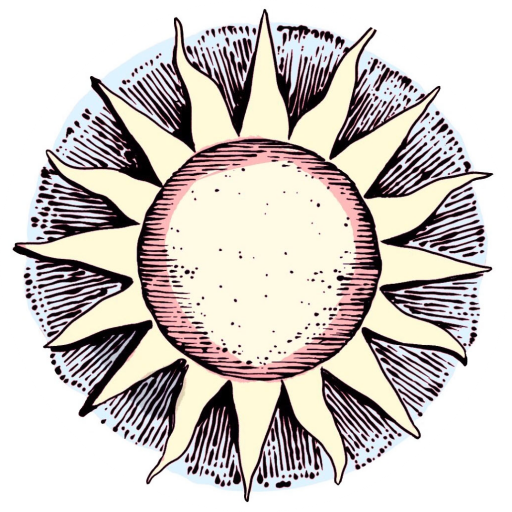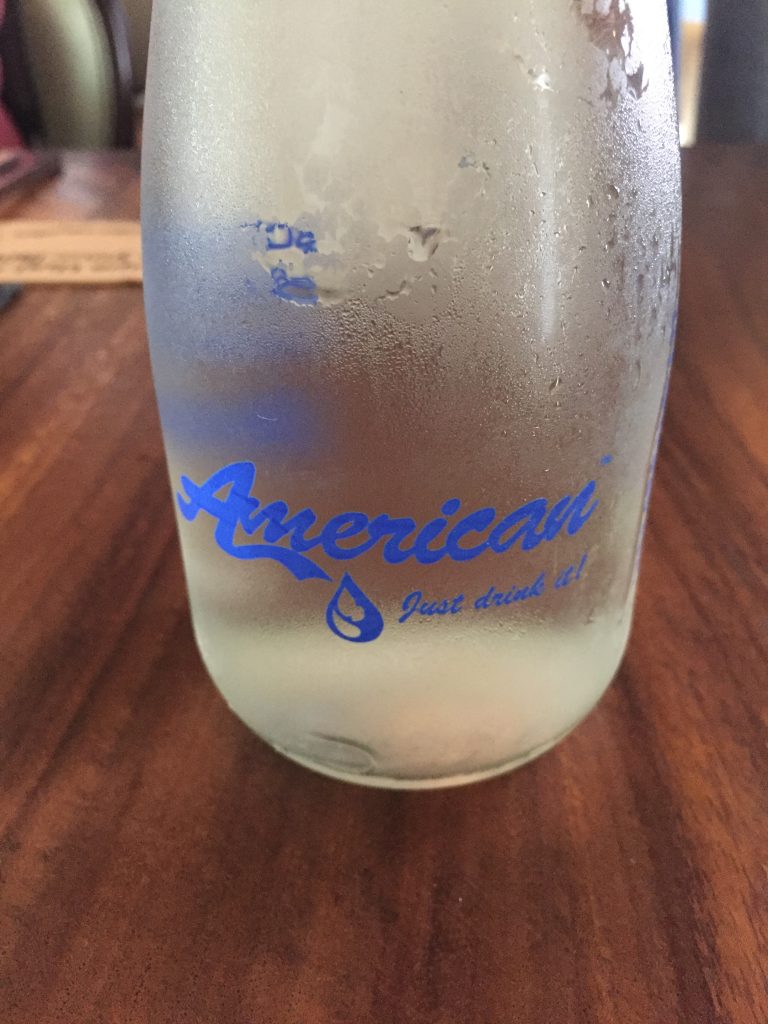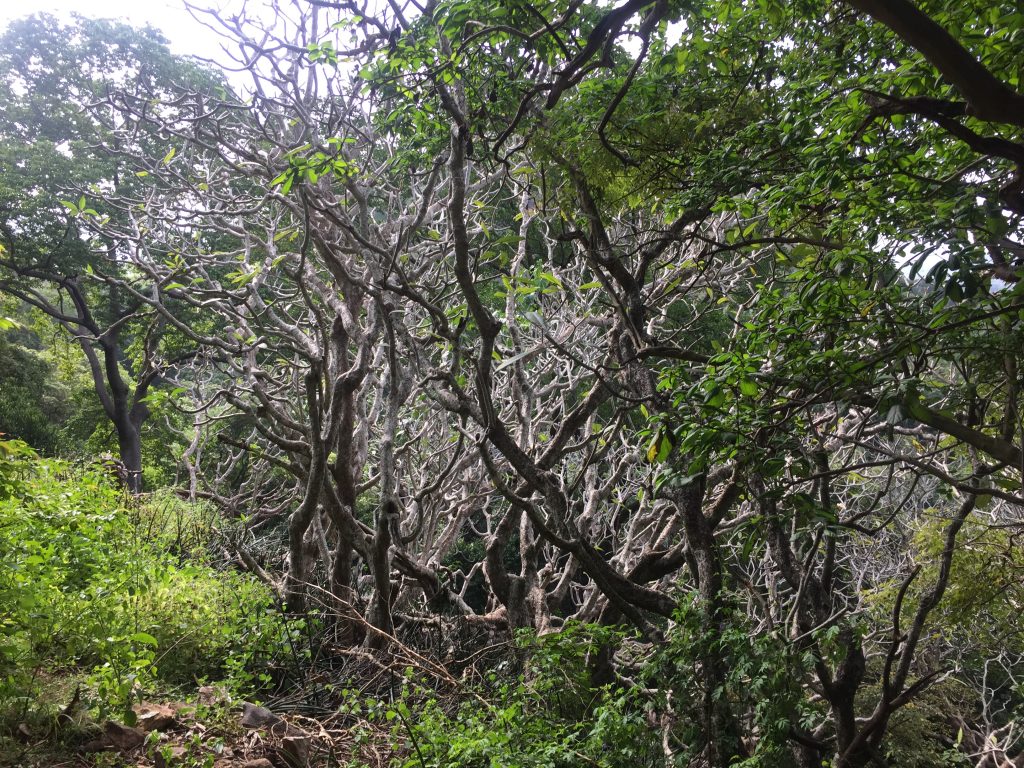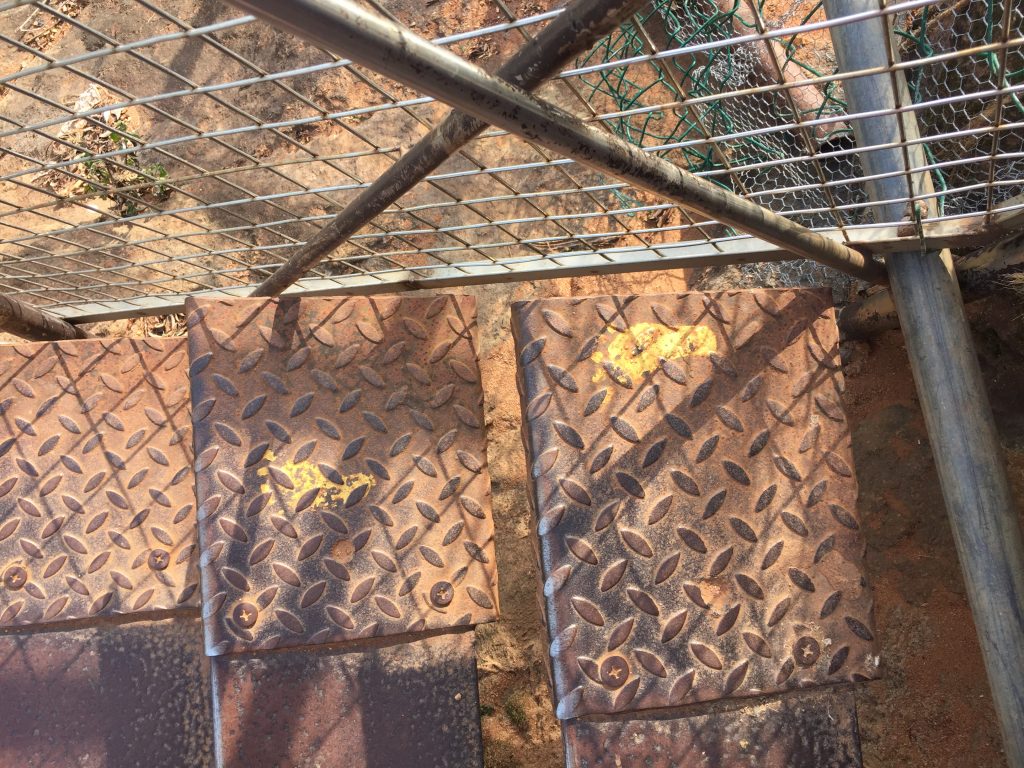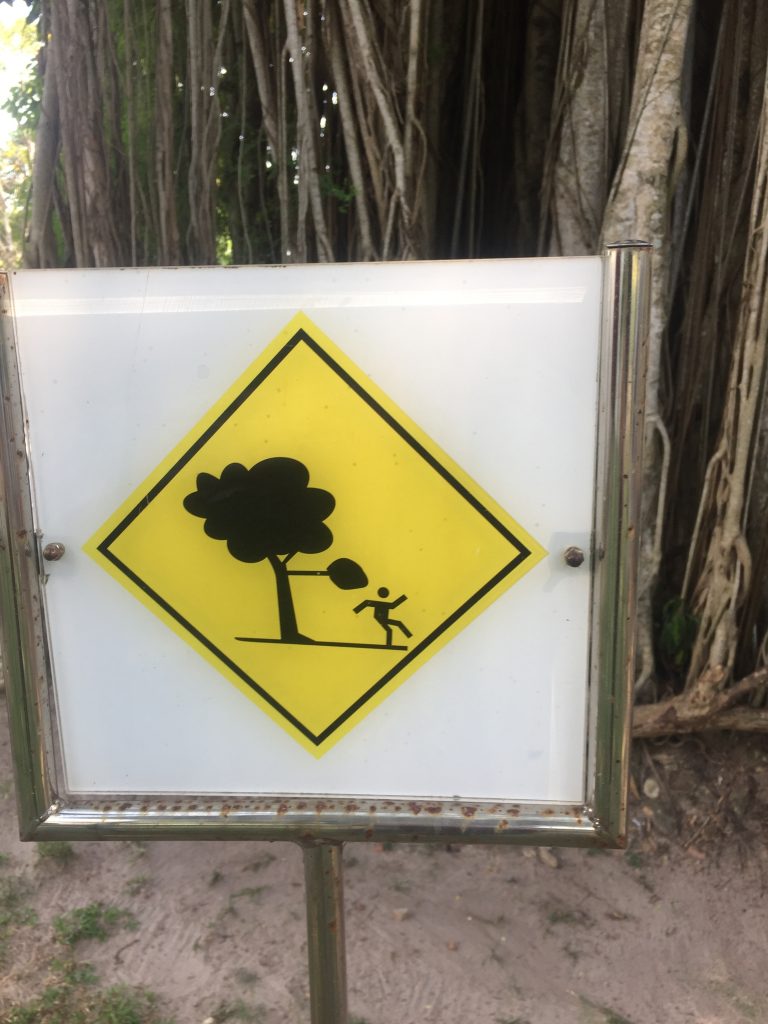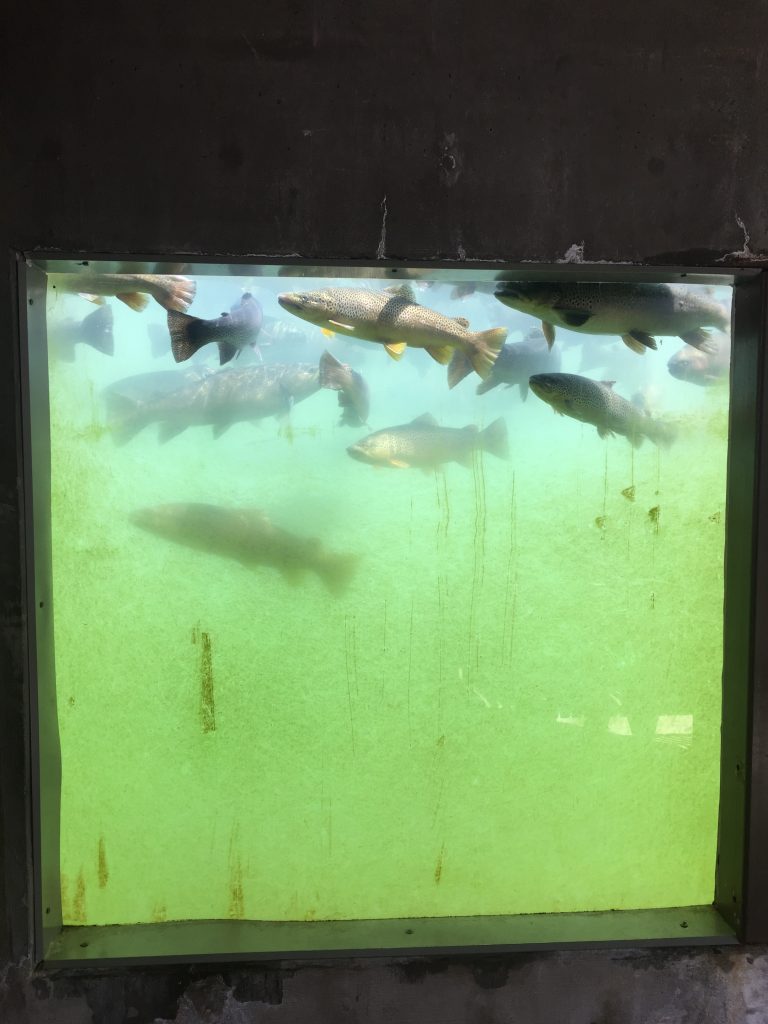
Having dwelled too long in the Midwest, perhaps, I expect to find ‘The Spring Herd’ displayed in some orderly fashion, it being among the privately-owned, eccentric-collection type oddities the Wayside has to offer and it being located in a field gone to weeds. On the contrary, I’m pulled over on the shoulder and trying to isolate the source of an off-tempo squeaking that I assume is coming from the motorcycle and find, when the wind blows, that it isn’t the bike at all. Just tall enough to peer over the underbrush, I spy the bobbing head of a cartoon penguin, weather-worn as to evoke images of the typical Hollywood apocalypse. I tap it with the toe of my boot and it rocks back and forth, squealing with the strain of rusted metal.
That’s the noise, all right. If it started ten minutes ago that puts me pretty much in the thick of it, I imagine, and as soon as I imagine it, the wind blows and ‘The Spring Herd’ begins screaming.
‘For the uninitiated, ‘spring rider’ refers to the ridable caricature of an animal attached to the ground with an industrial spring, allowing sober children and drunk or nostalgic adults to sway back and forth, side to side, and in deteriorating circles until the spring surrenders, leaning sadly to the ground, or the momentum of the animal is enough to drive the top of its head into the bottom of its rider’s. They come in pairs or groups of three and rarely represent a collection of a single species.
Insightful travelers may notice the dwindling of the American playground, both in number and in size. Parks are becoming fewer and, with their natural habitat dwindling, spring riders are nearing a state of endangerment. One family has exploited the peace between species of spring riders and created an unofficial, off-highway preserve in order to stave off their seemingly inevitable extinction. This collection of spring riders is referred to as ‘The Spring Herd,’ due both to the construction of the pieces and because they are best viewed in the spring, having risen from the snow and being not yet concealed by growth.
Visitors beware- though tame, the collective undulations of ‘The Spring Herd’ in the wind has been said to induce nausea in those who watch too long and, though the riders hardly suffer for it, there are carriers of lead and tetanus among them.’
I refuse to be seen on one of these creatures from the highway so I venture inward and have soon dropped far enough off the shoulder that the occasional rumble of passing trucks hardly rises above the crinkle of disturbed grass. The squawking of spring riders precedes the wind across my scalp by several seconds. Standing still, it’s clear they’re all around- some nearby, and some a long way’s off. Hundreds if not thousands. When the wind blows just right, it sounds so much like they’re coming toward me that my knees wobble with fight or flight.
I’ve come too early to see them together in the floral twilight between summer and fall (or autumn has too well maintained summer’s growth) but I eventually find a flaking alligator with my knee and upon recovering, I stomp out a small clearing. Precariously mounted, I am content to be carried for a while on the back of something older and wiser than me or anything I own.
Eventually, I’m convinced that ‘The Spring Herd’ is singing.
-traveler
After several days of attempting passage through the American Midwest I hole up in a motel, blocked in on all sides by ‘The Disaster.’ It’s hardly the first time I’ve had to alter plans to avoid ‘The Disaster’, but it normally exists in a relatively contained space. At the moment, it seems to stretch straight up the middle of the state. Local news doesn’t have much to say about the situation, but a split-second throwaway map during the traffic segment confirms what I had assumed- several red ‘X’s mark off the interstates for hundreds of miles in every direction. ‘The Disaster’ has formed a straight line.
‘The failure of early American infrastructure to manifest anything beyond the great sprawl of asphalt and gravel has just one benefit: options.
There is no place in America that can be reached in just one way. There is always a shortcut, a service road, or an extended turn-off that allows for some less-convenient but available improvisation when the normal methods fall through. Oil is America’s lifeblood and, like the circulatory system, the roads have spread in such a way to allow for some… chaotic redundancy, sometimes looping back on itself, yes, sometimes feeding strange tumors in the Wayside, and sometimes becoming so stretched as to be near collapse.
‘The Disaster’ seems, initially, to be the system’s opposing force. It occurs as a physical blockade, patrolled by government officials in hazmat gear and is as likely to appear on a privately-owned backroad as it is on the interstate. It is difficult to breach ‘The Disaster’s’ blockade and seemingly impossible to return from the inside. Those who have taken it upon themselves to blast through the gates are not seen again, dead, detained, or kept in perpetual quarantine.
On the other hand, ‘The Disaster’ is normally easy to circumvent, often taking up such a small length of road that barricades on one side of the perimeter can be viewed from the side opposite. Detours are generally unaffected, lending some credence to the supposition that ‘The Disaster’ does not oppose the rambling infrastructure but, rather, encourages it. Occurring in the worst possible place, ‘The Disaster’ sometimes inspires drivers to breach the sacred fontanel between the place they are and the place they must go. Curbs are flattened, medians erode, and gates are unlocked, further complicating the American maze.
‘The Disaster’ itself appears relatively contained for all that it occurs constantly and across the states. Those manning the barricade will admit to very little about it and are careful not to make promises regarding how long it may last or what form it takes beyond the barrier. They are calm, at least, harried only by those who attempt a premature crossing and dangerously competent in reaction to a breach.’
I may be among the first 20 or so people that notice the strange shape of ‘The Disaster.’ For all its persistence and all that it suggests some great, vague conspiracy, there isn’t much online interest in tracking ‘The Disaster.’ It’s easy to research specific instances of it, but the real work of an up-to-date system involves separating out hoaxes and other, mundane disasters from the big ‘D.’ It would be a lot of work for not a lot of pay-off and the suits at the barricade don’t exactly go out of their way to dispel the notion that anybody who does the work will find themselves offline permanently.
I’m able to find a stream of the news broadcast and capture a frame with the local traffic map. It fits nicely with several others people have posted, some of which are, admittedly, a little less credible. Someone has taken a picture of a paper road map with red tape showing a similar blockage in the south. Another poster has scribbled a map of Alabama and indicated closures there. Removing those, however, still leaves a clear pattern of pictures and maps and coordinates like mine, all from the last day or so. ‘The Disaster’ seems to have split the country straight down the middle.
I watch the forums. An argument evolves, one side sure that the line dividing the east and west is solid, that the population is purposefully being split, while the other argues that holes in ‘The Disaster’ are not due to lacking information but a ploy to funnel traffic into specific areas. As is often the case, neither side has much evidence to support their claim and it eventually devolves into something altogether uninteresting.
I take a shower and lay in the bed for a while, listening to the cars outside. The Stranger’s ‘Release of Burden’ has found a permanent home in my wallet- I fish it out and wonder if this is what he meant. This drive is something that I may never see to completion. It may not have a clear direction or a clear goal. There is always more work to be done, which was part of the appeal, initially at least. Now I find myself happy for an excuse to rest and not at all curious as to what ‘The Disaster’ heralds.
-traveler
‘There is no act more arrogant than that of stacking rocks along a path. There is no need for it but to prove that a past traveler has conquered a pass or sat meditating at a pond previous to those in the present. The anonymity of the ‘Rock Tower’ (versus more traditional forms of vandalism) further makes the point- the structure is no modern tomb, no personal memorial. It does not exist as a medium with which a person’s name might live on after them. It is, at best, the licking of a baked good, the unnecessary reminder that others have come first, traveled further, and had the time for idle activities. It is an insistence that denizens of the present are merely shadows cast by those who came before them.
There are two approaches in the conquering of a ‘Rock Tower.’ The creation of a new, more complex tower is the common choice. It is proof that the past can be beaten at its own game, though this is accomplished at the detriment of the future (where this method becomes increasingly difficult) and to the relative indifference of the past (the progenitors never having to face their defeat). It is the opinion of the author that the propagation of ‘Rock Towers’ is always a failing move.
The only appropriate answer, then, is the toppling of ‘Towers’ and the dispersion of rocks, though opponents would rightfully suggest this is a strategy better suited to the philosophy of the Strangers. It is one of only a few origin stories given much credence, that the most dedicated, the most fastidious Rangers are the most likely to convert. The narrative suggests that the Ranger philosophy will be warped after decades of patient trail-cleaning. After years of hauling rocks back to where they belong, after weeks spent dismantling tedious stone structures, after one last ‘Rock Tower’ collapses painfully across a leg, the Ranger is martyred on the path and replaced by the Stranger, who violently pursues the same goals.‘
-excerpt, Autumn by the Wayside
‘There is a public “discovery” of the ‘Graycard’ phenomenon every few years, they being featured middle-way through a ‘Top 10 Games You Never Knew Existed” list or a regional tournament being live-streamed via the hidden camera of some exhibitionist onlooker. Despite these minor publicity spikes and despite the wide, if shallow, public knowledge of their existence, actual acknowledgment of ‘Graycards’ outside of the Wayside is perpetually tenuous. Most people will have seen the booster packs in gas stations before and some of those people, likely those who have pushed them aside for other collectible cards, will be able to describe the game’s motif without realizing.
For example, they will never remember ‘Graycards’ as having their own hook on a display or box on a shelf. They will have noticed them accidentally mixed in with other cards or, more often, in loose piles behind the cases of other games. They will remember the packs as looking aged and crumpled, dusty and potentially stained by whatever may have leaked in the truck that stocks the station. They may remember the lack of art and the poor title layout, as though ‘Graycards’ only exist as a bootleg of themselves. Most who have owned ‘Graycards’ have been gifted them by grandparents who don’t understand the differences between games and are happy to save a dollar. They are sometimes handed over wordlessly with a receipt for unrelated products as part of some un-advertised special.
Inexplicably, ‘Graycards’ exist in the peripheries by design. The tarnished foil of their booster packs is printed on, as is the dust and staining. Packaging becomes duller year by year. The brand that supposedly prints the cards changes with each set and a little research reveals none of the companies have ever existed. The less-than-ideal shelf placement stems from the perpetual low stock and low turnover. The placement and the packaging feed into each other and the cycle maintains the product’s relative camouflage among items that are designed to draw attention.
The cards themselves are well-made and rarely as damaged as they seem from the outside. Styles vary set by set with a few clear patterns. Each set is characterized by a single color in addition to grayscale illustrations. Each set contains sporadic cards on which the lettering is printed in silver ink (seemingly the ‘foil’ of ‘Graycards’). Every known card has the same back- a series of nested circles in black and white. This pattern is mirrored by a small holographic circle on the corner of the face-side, acting as a mark of authenticity and making it difficult to scan or even take quality pictures of the cards.
‘Graycards’ seem only to emerge in booster packs and, as such, there is no official source for rules. Several popular variations of play exist and can be found online, their sources inevitably the writings and experiences of those who played before the internet allowed for such collaboration. Though the bulk of rules are agreed upon, regional variations represent another obstacle in the popularity of the game. A winning deck in the northwest will be entirely incompatible with a tournament in the south.
New ‘Graycard’ set releases are sporadic and frustrating enough that most believe it is another means by which the creators of the game sow discord among the playerbase. Booster packs for historical sets (say, the Ultraviolet Crimson set, widely available in 1994) will reappear in bulk decades after their initial printing. Promotional singles have been known to fall out of chip bags, condom boxes, and cases of car oil. It’s rare that a tournament occurs without the debut of an otherwise unknown card that defuncts prize-winning decks and overturns the meta understanding of the game, usually prompting accusations of cheating and forgery. Backhandedness is encouraged by a number on each card that seems to indicate how many of its kind have been printed. The collection or destruction of specific cards in order to boost power and rarity is common. At least one card, ‘The Eavesdroplet’ from 1988’s Pale Beige set, is thought to have been made extinct by these practices.
The inclusion of ‘Graycards’ in tournaments and conventions are relatively common, though the events are rarely a headline attraction and are commonly relegated to the conference rooms of nearby hotels. Perpetual travelers that add a pack of ‘Graycards’ to their gas-station lunches now and again can easily turn a profit at such a get-together, the serious playerbase being one that does not get out all that much. In fact, this pseudo-pollination seems to be the only mechanism in place to keep ‘Graycards’ afloat, it being a game that resists playing.’
You might imagine the cool stab of fear I experience upon opening the Stranger’s copy of ‘Autumn by the Wayside’ and seeing a black and white card flutter to the ground, seemingly a forgotten keepsake made bookmark. It bears an uncanny resemblance to a card I carry in my own copy- the Traitor from my days of playing with Sebastian’s group. The one is clearly inspired by the other, Sebastian himself having created the game while working at a gas-station. The phantom pains of my burn-scarred arm ease as I mark the differences and assure myself that his was a curse dispelled.
I’ve seen the packs of ‘Graycards’ now and again. They’re difficult to miss if you spend enough time on the road. I even followed the advice in Shitholes once, buying them up until I had a little shoebox of boosters to sell out of the back of the truck at a college campus. The buyers, though… The people who showed up asked me where each pack had come from and how long I had had them. They pulled up the flaps and inspected small markings in the creases. One woman asked if she could weigh the packs before purchase with a little jewelers scale. Selling the cards made me feel dirty, as though I was feeding an addiction I didn’t totally understand. The profit was good, even accounting for the time I sat there, but I’ve never done it again.
The Stranger’s card is one called ‘Release of Burden’ and, if the entry is correct, it’s one of a thousand like it. The illustration is of a haggard man’s face as he reclines backward into a chair. It’s printed in grayscale, of course, except for a very faint blue shading as though the scene is illuminated by an out-of-frame television. One of several wiki-style forums suggest its from a set released in the mid-2000’s: the Pastel Blue set. The rules on the card mean nothing to me, but the man’s expression lingers in my mind the rest of the day. I set up camp off an unmarked service road and slide into my sleeping bag, balancing the card up against the tent wall. The man’s face is emotionless and, in that neutrality, I can project both relief and disenchantment.
I fall asleep, wondering what the Stranger may have seen in it.
-traveler
‘In the creation of road signs, the Federal Highway Administration sometimes struggles with tone. Take, for instance, the well-known paranoia cycle that exists along I-80, where signs warn travelers of a nearby prison and suggest hitchhikers are potentially more of a threat in the region than they are normally. Not an unreasonable message in and of itself, but some budgetary or communications breakdown led the signs to be placed every half mile so that, in many stretches, several of the signs can be seen leading off into the horizon. The effect is nerve-wracking- the difference between a friendly ‘watch your head’ as a tall friend approaches a short door and the shouting of the phrase over and over, as though a rogue frisbee approaches.
The dread produced along I-80 is felt to keenly that several instances of vehicular homicide have occurred based on the assumption of a driver that someone on foot meant them harm. Iowa’s knee-jerk reaction to the growing problem was the addition of a second series of signs that target pedestrians, warning them that drivers in the area may swerve erratically across the curb. The new message only encouraged walkers to draw attention to themselves as cars passed, often waving lights or gesturing widely in ways that were considered hostile by on-edge drivers. So much more harm came to hikers (hitch- or otherwise) that it became common practice to carry rocks on I-80 and to pelt nearing cars so that traffic was forced into the center lanes.
Most recently, the Federal Highway Administration has added a third sign warning drivers that people on the side of the road may throw rocks. These signs are smaller and fixed just below the originals, as though attempting to convey apology both for the problem and for the relatively ineffectual solution.’
I’m not sure where pedestrians stand on motorcyclists until something slams into the visor of my helmet, splitting the hard plastic across the center. I pull it up until the rock-strewn pavement forces me away from the center and toward the curb. A dirt-clod that barely misses my head explodes in front of the bike, creating a cloud of dust and grit that immediately blinds me. I manage, somehow, to maneuver to the shoulder without crashing or swerving toward another malicious group of bystanders. It takes 10 minutes to rinse the dirt from my eyes. The first thing I see is the cartoon outline of a car driving off the highway toward someone on the side, its cartoon driver waving a little cartoon fist. Warning, it says, drivers may target pedestrians.
The second thing I see is a car behind the sign, speeding toward me.
I dive off into the brush beside the road and, hearing it pass, leap out with a stick in my hand. I fling it impotently in the driver’s rearview mirror.
Anger churns inside me. My eyes water and my body aches from landing on the ground. Another car is coming and it isn’t until I see my shadow wielding a stone that I realize I’ve picked one up myself. I take several steps back and drop it. The passing car sound its horn; it’s as likely a warning as it is a ‘thank you.’
I wave, regardless. Let them make of it what they will.
-traveler
Rear View Mirror
- December 2025
- November 2025
- October 2025
- September 2025
- August 2025
- July 2025
- June 2025
- May 2025
- April 2025
- March 2025
- February 2025
- January 2025
- December 2024
- November 2024
- October 2024
- September 2024
- August 2024
- July 2024
- June 2024
- May 2024
- April 2024
- March 2024
- February 2024
- January 2024
- December 2023
- November 2023
- October 2023
- September 2023
- August 2023
- July 2023
- June 2023
- May 2023
- April 2023
- March 2023
- February 2023
- January 2023
- December 2022
- November 2022
- October 2022
- September 2022
- August 2022
- July 2022
- June 2022
- May 2022
- April 2022
- March 2022
- February 2022
- January 2022
- December 2021
- November 2021
- October 2021
- September 2021
- August 2021
- July 2021
- June 2021
- May 2021
- April 2021
- March 2021
- February 2021
- January 2021
- December 2020
- November 2020
- October 2020
- September 2020
- August 2020
- July 2020
- June 2020
- May 2020
- April 2020
- March 2020
- February 2020
- January 2020
- December 2019
- November 2019
- October 2019
- September 2019
- August 2019
- July 2019
- June 2019
- May 2019
- April 2019
- March 2019
- February 2019
- January 2019
- December 2018
- November 2018
- October 2018
- September 2018
- August 2018
- July 2018
- June 2018
- May 2018
- April 2018
- March 2018
- February 2018
- January 2018
- December 2017
- November 2017
- October 2017
- September 2017
- August 2017
- July 2017
- June 2017
- May 2017
- April 2017
- March 2017
- February 2017
- January 2017
- December 2016
- November 2016
- October 2016
- September 2016
- August 2016
